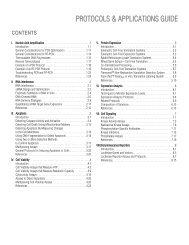2012 Promega catalogue
2012 Promega catalogue
2012 Promega catalogue
Create successful ePaper yourself
Turn your PDF publications into a flip-book with our unique Google optimized e-Paper software.
Cell Signaling<br />
Dual-Glo ® Luciferase Assay System<br />
Product Size Cat.# Price ($)<br />
Dual-Glo ® Luciferase Assay System 10 ml E2920 479.00<br />
For Research Use Only. Not for Use in Diagnostic Procedures.<br />
100 ml E2940 Pls. Enq.<br />
10 × 100 ml E2980 Pls. Enq.<br />
Description: The Dual-Glo ® Luciferase Assay System is a homogeneous<br />
reagent system that enables fast and simple quantitation of a stable<br />
luminescent signal from two reporter genes in a single sample. This convenient<br />
“add-and-read” system generates both firefly and Renilla luciferase luminescence<br />
signals from cells that have not been preconditioned or prelysed. The<br />
Dual-Glo ® Luciferase Assay System provides high Z´-factors for cell-based,<br />
high-throughput screening applications. With the Dual-Glo ® System, internal<br />
controls can be established to minimize sample variability by reducing false<br />
positive and false negative readings caused by nonspecific factors such as<br />
cytotoxicity. In the Dual-Glo ® Luciferase Assay, the activity of the primary<br />
reporter is correlated with the effect of specific stimuli, and the activity of the<br />
co-transfected control reporter provides an internal control to normalize results.<br />
The system is optimized for batch processing both 96- and 384-well plates<br />
and is compatible with a wide variety of mammalian cell culture media.<br />
Features:<br />
• Increased Precision and Accuracy: Normalize primary reporter results<br />
with an internal control, a co-reporter that minimizes effects of cell number<br />
and health, transfection efficiency and nonspecific cellular responses.<br />
• Homogeneous Format: Perform fewer steps. Assay cells directly in<br />
growth medium for both reporters. No centrifugation or lysis step is<br />
required.<br />
• Stable Signal: Obtain flexibility for either batch or continuous processing<br />
of 96- and 384-well plates. Each luminescent signal may be measured for<br />
up to 2 hours after reagent addition.<br />
• Convenience: Screen efficiently with this simple, two-step assay that is<br />
ideal for any luminometer. On-board injectors not required.<br />
• Wide Dynamic Range: Analyze high and low reporter activity without<br />
sample dilution. Linear over at least 6 logs of enzyme concentration for<br />
each reporter.<br />
• Choose Your Configuration: Learn more about our custom options for<br />
this product at: www.promega.com/myway/<br />
Storage Conditions: Store Dual-Glo ® Substrates at –20°C. Store Dual-Glo ®<br />
Buffers below 25°C.<br />
Protocol Part#<br />
Dual-Glo ® Luciferase Assay System Technical Manual<br />
TM058<br />
Dual-Luciferase ® Reporter Assay System<br />
Product Size Cat.# Price ($)<br />
Dual-Luciferase ® Reporter Assay System<br />
Dual-Luciferase<br />
100 assays E1910 398.00<br />
® Reporter Assay System<br />
10-Pack<br />
Dual-Luciferase<br />
1,000 assays E1960 2555.00<br />
® Reporter 1000 Assay<br />
System<br />
Available Separately<br />
1,000 assays E1980 2239.00<br />
Passive Lysis 5X Buffer 30 ml E1941 134.00<br />
For Research Use Only. Not for Use in Diagnostic Procedures.<br />
Description: The Dual-Luciferase ® Reporter (DLR) Assay System provides<br />
an efficient means of performing two reporter assays. In the DLR Assay, the<br />
activities of firefly (Photinus pyralis) and Renilla (Renilla reniformis or sea pansy)<br />
luciferases are measured sequentially from a single sample. The firefly<br />
luciferase reporter is measured first by adding Luciferase Assay Reagent II (LAR<br />
II) to generate a luminescent signal lasting at least one minute. After quantifying<br />
the firefly luminescence, this reaction is quenched, and the Renilla luciferase<br />
reaction is initiated simultaneously by adding Stop & Glo ® Reagent to the same<br />
sample. Both assays can be completed in about 4 seconds using a<br />
For complete and up-to-date product information visit: www.promega.com/catalog<br />
luminometer with reagent auto-injectors. In the DLR Assay System, both<br />
reporters yield linear assays with attomole (100μl/well), additional Passive Lysis Buffer may be purchased separately.<br />
Features:<br />
• Greater Accuracy: Renilla luciferase internal control allows for more<br />
accurate results.<br />
• Convenient: Samples don’t have to be split, which saves plates and time.<br />
• Sensitive: Allows study of weak promoters, low-level expression/regulation,<br />
and expression in cells that transfect poorly.<br />
• Linear: Range extends 7 logs; very active samples typically do not need<br />
dilution.<br />
Storage Conditions: Store at –20°C.<br />
Protocol Part#<br />
Dual-Luciferase ® Reporter Assay System Technical Manual TM040<br />
Dual-Luciferase ® Reporter 1000 Assay System Technical Manual TM046<br />
Percent Optimal Transfection<br />
120<br />
80<br />
40<br />
0<br />
Optimal Transfection<br />
Suboptimal Transfection<br />
None Protein Vector<br />
Method of Normalization<br />
Effect of transfection conditions on reporter results analyzed using<br />
different normalization methods. HEK 293 cells were transfected with<br />
pGL4.13[luc2/SV40] expressing firefly luciferase and pGL4.74[hRluc/TK]<br />
expressing Renilla luciferase. Transfections were performed using both<br />
optimal and suboptimal lipid:DNA ratios (indicated as Optimal and Suboptimal<br />
Transfection conditions). Firefly and Renilla luciferase activities were measured<br />
using the Dual-Luciferase ® Reporter Assay System (Cat.# E1960). Protein<br />
concentrations were determined using the Coomassie ® Plus Bradford Reagent<br />
(Pierce). Firefly luciferase data were either not normalized (None), normalized<br />
to total protein (Protein), or normalized to Renilla luciferase activity (Vector).<br />
Data represent the average ± standard deviation of triplicate samples and<br />
are expressed as a percent of the optimal transfection for each normalization<br />
condition.<br />
6398MA<br />
259<br />
15<br />
Reporter Assays and Transfection<br />
Section<br />
Contents<br />
Table of<br />
Contents
















